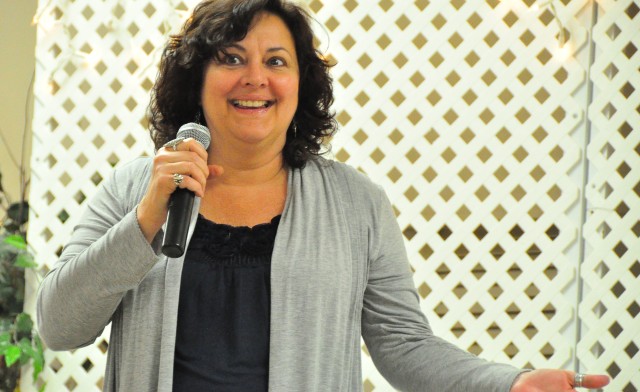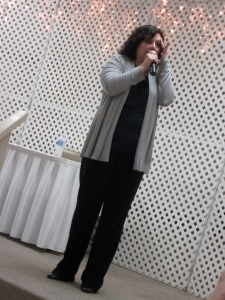Reality Cheque: Lunch with Gail Vaz-Oxlade

This past Saturday, I had the opportunity to have “Lunch with Gail” out in Coburg, Ontario. You may recognize Gail as the brash money-maven on Slice Network’s Til Debt Do Us Part and the new series Princess. If you’re not familiar, click here to catch up! Gail has also authored Never Too Late, Debt-Free Forever and Easy Money. The event was organized in party by Mortgages for Women with proceeds going to Northhumberland Services for Women. Gail was her usual to-the-point self, much shock and laughter ensued. She tells it like it is and we love her for it. If you ever get the chance to hear her speak, you won’t regret it. She’s HI-larious.Gail maintains that there are four money rules that hold true, no matter what shape the economy is in:
- Live within your means (don’t spend more than you make)
- Save for the future
- Eliminate Debt
- Prepare for emergencies
In the hour we had with Gail, she discussed SAVING MONEY. Here are some key take-aways that I thought were relevant to us Millennials:
Start saving NOW
- Thanks to the magic of compound interest, those of us that start retirement savings in our 20’s only need to put away 6% of our net income every year to enjoy a comfortable retirement. Start saving in your 30’s and that number jumps to 10%. Wait ’til you’re in your 40’s and that number increases to 18%. As you can see, you’ll make things way easier for yourself in the long-run if you start now.
Grocery shop with a list
- As long as you stick to what is on your list, you won’t be susceptible to the marketing tricks stores use to get you to buy things you don’t need. Plus you’ll be in and out of there in no time.
Consider your hourly disposable income when making impulse purchases
- For example. If you work 35 hours per week earning $1000 (net), the money you have left over after fixed expenses/incidentals/savings is called your ‘disposable income.’ To figure out your HOURLY disposable income, divide that $1000 by 35 hours. If you only have $75 left over, your hourly disposable income is $2.14. The new iPad retails for $500 – so it’s going to take you 234 hours to pay for it. Consciously doing this math will help you rationalize whether or not the purchase is worth all the effort.
- Gail explains that when people get a bargain…on groceries, for example… they often say that they “saved” on their purchase. If a can of tuna costs $2.00, and the store has them on sale “3 cans for the price of one,” buying 3 cans won’t actually save you any money unless you put that $4.00 you saved into a savings account. Leaving that $4.00 in your pocket just means you’re going to spend that money somewhere else and you didn’t actually end up saving anything. The same myth applies to using coupons.
Money Set Point
- Gail described a phenomenon that happens when people start putting money away. Sometimes people see how much money has accumulated in their bank accounts and it sets them off – they feel entitled to spend it. If, say when your savings account balance gets to $1500 you feel tempted to go on a shopping spree, that’s your Money Set Point. Move that money into something like a GIC or a TFSA where you can’t get to it as easily and restart saving another $1,500.
Financial Infidelity (Ha!)
- Hiding your purchases from your partner.
During the Q&A, I had an opportunity to ask Gail about strategies for saving for my first home. Essentially, my bank wants me to put all my money into an RRSP and take advantage of Canada’s Home Buyers’ Plan. Basically this would allow me to borrow up to $25,000 from my RRSP and take up to 15 years to pay the money back.
I don’t know about you, but this seems like an awful idea. Why on earth would I want to lose out on 15 years worth of compound interest? No wonder the banks like this plan.
Gail agreed that this option is less than ideal. After outlining how to come up with my monthly contributions (more on this later). We came to the agreement that, for my tax bracket, aiming to max out my TFSA (Tax Free Savings Account) would be the best strategy. The money will grow at a decent rate, I won’t be taxed on the interest earned, and I won’t have to pay it back.
The luncheon was rounded off with Gail’s book-signing. I have Gail’s books but they’re on my Kindle e-reader (I swear). So she gladly signed my budget notebook with a giant heart “Love Gail.” I’m pretty sure we’re kindreds now.
Gail posed one last question to the group of us at the end of her talk and I’m going to ask you the same question:
What one new thing are you going to do differently to save your money? Pick something and do it this week!
For more pictures from my Lunch With Gail, check out the Social NetWorth Facebook Page
And check these out as well:
Gail’s Blog: www.gailvazoxlade.com
Mortgages for Women: www.mortgages4women.ca




boy am i glad i stumbled apon your site,,,great information and great site
excellent work
Wow, that is amazing you were able to do a lunch n learn with Gail Vaz-Oxlade. She’s my idol! I think she’s every pf blogger//frugal person’s idol. lol. Just out of curiosity, how did you find out about this opportunity? Were you on a mailing list?
She doesn’t do these engagements very often. I found out about this one via Twitter friends :)